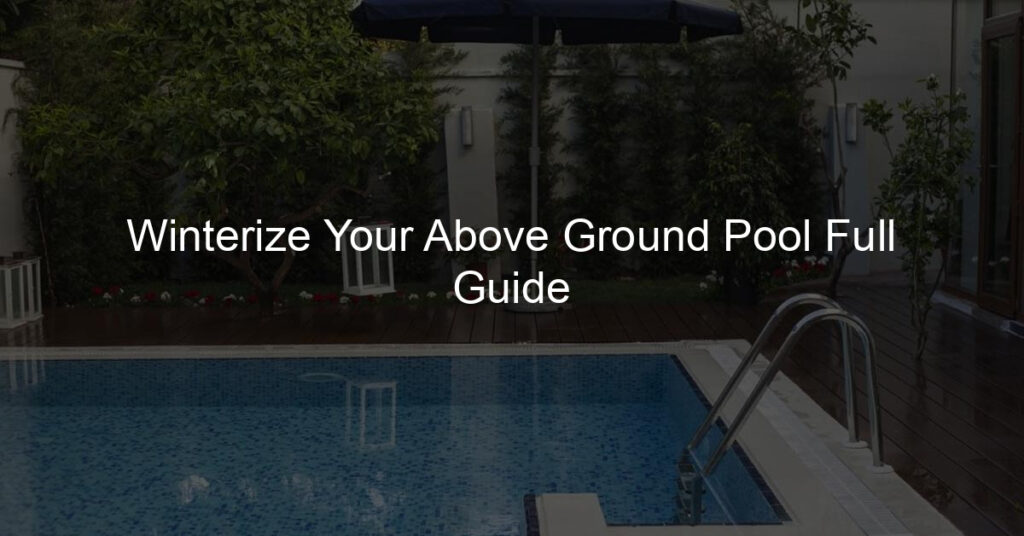Having a pool in the backyard can bring lots of memories, but when it comes to winterizing an above ground pool, the thought of having to put away your warm weather buddies and bundle up into a jacket can be difficult.
But fear not! Winterizing your above ground pool doesn’t have to be as daunting task as you think if you prepare accordingly and make use of a few tips & tricks along the way. It’s important that you take steps throughout the year for proper maintenance, but especially before putting your pool away for winter months.
In this guide we’ll share all essential steps necessary for successfully winterizing your above ground swimming pools so you’re ready with no worries when summer returns again!
Do you have to completely drain above ground pool for winter?
For many people, the summer months mean more than just high temperatures and humidity; they also mean time spent in the pool with family and friends. With that comes the question of how to prepare an above ground swimming pool for winter.
While it may seem obvious to drain the pool when transitioning from warm to cold weather, this is not necessarily necessary for many types of above ground pools. Knowing what type of pool you have and researching specific steps for maintenance can ensure that you retain both a safe and pleasant swimming experience even when it’s cold outside.
Making smart decisions about prepping your pool for winter can not only give you great benefits now but also keep your investment lasting for years to come!
How much chlorine is needed to winterize a pool?
Winterizing a pool is an important maintenance step to protect your investment and ensure that it is ready for use in the warmer months. Chlorine is the primary chemical used for this purpose, but the amount of chlorine needed varies greatly depending on what type of pool you have, where it is located and how long it will be closed for.
Generally speaking, it’s recommended to add 1-2 parts per million (ppm) available chlorine per 10,000 gallons of water. This amount can also be adjusted based on water temperature and sunlight exposure. As always when dealing with pool chemicals, it’s best to consult a professional for personalized advice about winterizing your pool safely and effectively.
What is the easiest way to drain an above-ground pool?
Draining an above-ground pool can be a difficult task if you are not familiar with the process, but it doesn’t have to be! If your filtration system doesn’t contain a sump pump or another method of draining your pool, the easiest method would be to simply open one side (or more) of the pool so that gravity drains the pool.
It may take some time to drain completely but is typically the most efficient way within a limited environment. Be sure to keep an eye on it so that all of the water drains away, as leaving any standing could damage your liner over time. By taking these steps you will easily lessen the burden of draining and maintaining your above-ground pool.
Do you have to drain the pool below the skimmer for winter?
As summer comes to an end, there is a common question that arises: do you have to drain your pool below the skimmer for winter?
The answer will depend on the type and condition of your pool. If you own an in-ground vinyl or fiberglass pool, draining it below the skimmer is perfectly safe.
This could give your pool’s equipment a more extended life since it prevents them from being submerged during freezing temperatures. On the other hand, if you own an above-ground or intex pool, draining it below the skimmer could cause serious damage due to pressure buildups. At this point, water should only be lowered a few inches below its normal levels.
Whatever type of pool you own, make sure to never leave standing water inside over winter as this can lead to cracking and warping which could result in costly repairs.
What happens if you don’t cover your above-ground pool in the winter?
Keeping your above-ground swimming pool covered in the winter is an important step in ensuring that it remains usable and safe for swimming throughout the year. Without a cover, your pool can suffer from a variety of damages, including broken down ladders, cracks in liners, and even pop-outs caused by shocks of cold temperatures below the surface of the pool.
Also, a lack of coverage leaves your pool open for debris such as debris falling into the water or leaves clogging up any filters you have installed. This may all result in costly repairs or replacements due to neglecting to purchase and use an appropriate winter cover for your above-ground pool.
What chemicals do I need to winterize my above ground pool?
For pool owners, winterizing can be daunting. To ensure your pool is properly prepared for winter, there are a few key chemicals you need to add to the water. The most important of these is chlorine shock to cleanse the pool and its components from any bacteria or algae that had been lingering throughout the season.
Next, you’ll want to add algaecide or a phosphate remover to prevent algae growth in colder climates. Finally, you should use a water stabilizer to reduce pH level changes and protect the pool liner from potential weathering damage during colder months.
Proactive measures like these will help ensure your above ground pool survives winter safe and sound!
When to Winterize Your Above Ground Pool?
It’s important to winterize your above ground pool when the temperature consistently falls below 60°F. This is because any water that remains in the pool will freeze and expand, potentially damaging its walls, filter system, and other components.
Additionally, it’s recommended to winterize before the first frost of fall. This can prevent corrosion from occurring due to rain or snow collecting on the pool’s surface and freezing into a solid mass.
Don’t wait until it’s too late – be sure to prepare your above ground swimming pool for winter now! Doing so can help ensure that you enjoy your summer fun with friends and family again next year without worry!
Shock The Pool Before You Close It
It’s important to shock your above ground pool before you close it for the winter. This means adding a large dose of chlorine to the water to disinfect and eliminate any contaminants that may have built up during the summer months.
This will also help prevent algae growth, which can form quickly when temperatures start to drop. To ensure maximum protection, you should shock your pool at least every other week during fall until complete closure. Doing so will make sure your pool is ready for use again as soon as warm weather returns!
Clean The Filter System Before Closing
Before closing your above ground swimming pool for the winter, it’s essential to clean the filter system. This is necessary because debris can build up over time, leading to clogs and inefficient filtering.
To clean the filter, you must first turn off the system and disassemble it according to its manufacturer’s instructions. Once this is done, you can hose down each component with a garden hose or pressure washer and then reassemble the unit according to its manual. This will ensure that your filter system is ready to use again come springtime!
Clean Your Pool One Last Time
Before closing your pool for the winter, you should give it one last cleaning. This means skimming off any leaves or debris that have accumulated on top of the water and scrubbing down any walls or surfaces with a brush or vacuum.
This will ensure that all contaminants are removed before being sealed away under the cover and will make reopening your above ground pool much easier come summertime!
Put Away Equipment Properly After Winterizing Your Above Ground Pool
Once your above ground swimming pool has been successfully winterized, it’s important to properly store any equipment you may have used during the process. This includes anything from chlorine tablets to shock treatments and algaecides.
Be sure to store these in a dry place and away from extreme temperatures. Additionally, you may want to consider labeling them with the expiration date so they can be discarded and replaced when necessary come warmer weather.
By taking these steps, you’ll ensure that all components and supplies are ready for use again when reopening your pool in the summertime!














